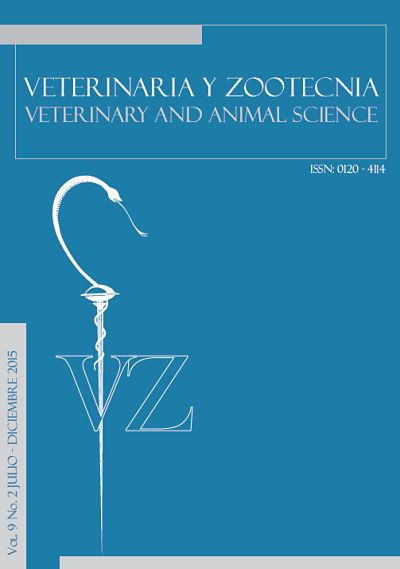Authors
Abstract
The melissopalinology allows to characterize the honey of bees according to their botanical and geographical origin, to allow identifying their physicochemical characteristics. Thus, melissopalinology of honey produced in a white clover (Trifolium repens) culture was determined. White clover cultivation was planted and a hive of Apis mellifera was installed adjacent to the crop. The variables pollen size and morphology of the honey in two seasons and the type of pecoreated species were determined. Differences between epochs were analyzed using the Chi-square test and Student-t for shape and size respectively, in addition to descriptive statistics. The main taxonomic species found in honey belong to Solanaceae, Brassicaceae and Fabaceae, being classified as polyfloral honey. White clover pollen did not present the highest value in honey, but it was among the main pecoreated species, reaching 20.9% in the samples. The results between periods did not show statistical differences. The average size of the white clover pollen grain was 25.7 micrometers, being an acceptable value for the bees and the shape was characterized by being spherical and curved in the center and flatter in the periphery.
Keywords:
References
Barth, O. Melissopalynology in Brazil: A review of pollen analysis of honey, propolis and pollen loads of bee. Science Agriculture (Piracicaba Braz), v.61, n.3, p. 342-350, 2004.
Calderón, H. Abejas, la miel y sus productos. Biblioteca ilustrada del campo. Bogotá. Colombia: Biblioteca latinoamericana, 2004. 131p.
Chauvin, R. "Les abeilles et moi". France: Hachette, 1976. 162p.
Cornejo, L. Polen, tecnología de su producción, procesado y comercialización. La Plata. Argentina: Iptea, 1994. 114p.
Criollo-Urrego, D.; Córdoba-Gómez, J. & Insuasty-Santacruz, E. Análisis melisopalinológico de la miel obtenida en el apiario de la granja experimental Botana.Investigación Pecuaria, v.2, n.2, p.49-57, 2013.
Crompton, C. & Wojtas, W.A. Pollengrains of Canadian honey plants. Centre for Land and Biological Resources, Canada: Agriculture Canada, 1993. 33p.
Erdtman, G. Handbook of Palynology. New York, USA: Haffner Publication Co. 1969. 320p.
Faricelli, M.; Kraus, T.A. & Bianco, C.A. Análisis palinológico de las especies melitófilas de la familia Fabaceae del centro de la Argentina. Revista FAVE. Ciencias Agrarias, v.3, n.1-2, p.13-23, 2004.
Felsner, M.; Cano, C.; Bruns, R. et al. Characterization of monofloral honey by ash contents through a hierarchical design. Journal of Food Composition and Analysis, v.17, p.737-747, 2004.
Herrero, B.; Valencia-Barrera, R.; San Martín, R. et al. Characterization of honeys by melissopalynology and statistical analysis. Canadian Journal of Plant Science, v.82, p.75-82, 2002.
Nates-Parra, G.; Montoya, P.M.; Chamorro, F.J. et al. Origen geográfico y botánico de mieles de Apis mellifera (Apidae) en cuatro departamentos de Colombia. Acta Biológica Colombiana, v.8, n.3, p.427-438, 2013.
Louveaux, J.; Maurizio, A.; Vorwohl, G. Methods of Melissopalynology. Bee World, v.59, p.139-157, 1972.
Piedras-Gutiérrez, B. & Quiroz-García, D.L. Estudio melisopalinológico de dos mieles de la porción sur del Valle de México. Polibotánica, v.23, p.57-75, 2007.
Ramírez, Y. Efecto del tiempo de secado en las características fisicoquímicas, microbiológicas y sensoriales del polen de abejas (Apis mellifera). Zamora, Honduras: Escuela Agrícola Panamericana, 2016. 31p. Tesis (Ingeniería en Agroindustria Alimentaria).
Sánchez, C. Crianza y Producción de Abejas. Apicultura. Lima 36-Peru: Colección Granja y Negocio, 2003. 135p.
Sareen, S. Variability in white clover from the Indian Himalaya. India: Regional Research Centre. Indian Grassland, Fodder and Agroforestry Research Institute. HPKV Campus Palampur, 2003. 100p.
Sawyer, R. Honey Identification. Cardiff, UK: Cardiff Academia Press. 1988. 420p.
Von Der Ohe, W.; Persano, L.; Piana, M. et al. Harmonized methods of melissopalynology. Apidologie, v.35, p. S18-S25, 2004.
Wanzenried, R; Gaggiotti, M; Caporgno, J. et al. Caracterización botánica de mieles del centro de la provincia de Santa Fe. Memorias Congreso Internacional de Alimentos, 2001-2003, Córdoba, Argentina., 2006. p. 458.

 pdf (Español (España))
pdf (Español (España))
 FLIP
FLIP














